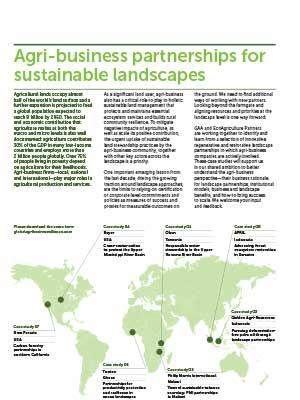
Agricultural lands occupy almost half of the world’s land surface and a further expansion is projected to feed a global population expected to reach 9 billion by 2050. The social and economic contribution that agriculture makes at both the macro and micro levels is also well documented: agriculture contributes 30% of the GDP in many low-income countries and employs more than 2 billion people globally. Over 75% of people living in poverty depend on agriculture for their livelihoods. Agribusiness firms—local, national and international—play major roles in agricultural production and services.
As a significant land user, agribusiness also has a critical role to play in holistic sustainable land management that protects and maintains essential ecosystem services and builds rural community resilience. To mitigate negative impacts of agriculture, as well as scale its positive contribution, the urgent uptake of sustainable land stewardship practices by the agribusiness community, together with other key actors across the landscape is a priority.
One important emerging lesson from the last decade, driving the growing traction around landscape approaches, are the limits to relying on certification or corporate level commitments and policies as measures of success and proxies for measurable outcomes on the ground. We need to find additional ways of working with new partners. Looking beyond the farm-gate and aligning resources and priorities at the landscape level is one way forward.
GAA and EcoAgriculture Partners are working together to identify and learn from a selection of innovative regenerative and restorative landscape partnerships in which agribusiness companies are actively involved. These case studies will support us in our shared ambition to better understand the agribusiness perspective—their business rationale for landscape partnerships, institutional models, business and landscape benefits, and how to bring success to scale. We welcome your input and feedback.
Our shared intention is to build on this initial set of case studies over time and strengthen our collective understanding of how to build successful agribusiness landscape partnerships. This first tranche already provides some valuable insights. For companies, issues such as water supply, human rights or deforestation —which they cannot fully control within their own operations—are strategic entry-points into landscape-level dialogue and action plan. The ‘landscape approach’ can help companies align and link historically disparate strategies, for example for water and sustainable sourcing.
The role of multi-stakeholder platforms in helping to navigate multiple and diverse interests/priorities, including across different industries (e.g., mining and agriculture) and different government ministries is key. They also provide value in supporting stakeholders to identify and navigate trade-offs and synergies. The agribusinesses all reported concrete business benefits generated from healthier ecosystems and improved ecosystem management promoted by their partnerships.
The cases demonstrate the diverse roles that agribusinesses can play in landscape partnerships—as convener, co-organizer, member, technical innovator and more—depending on business interests and institutional context. The rich variety of partnership models reflects the importance of designing and adapting them to meet local landscape needs. While several of the agribusinesses valued company-led models, others noted the importance of the business partner stepping-back and not ‘owning’ the process/governance, and noted the need for a ‘neutral and credible convener and leader. All of the companies emphasized the importance of farmer/landowner engagement and highlighted the urgency in delivering benefits for them. Several noted the value of governments endorsing company-led partnerships, or effectively coordinating or collaborating in multi-stakeholder platforms.

